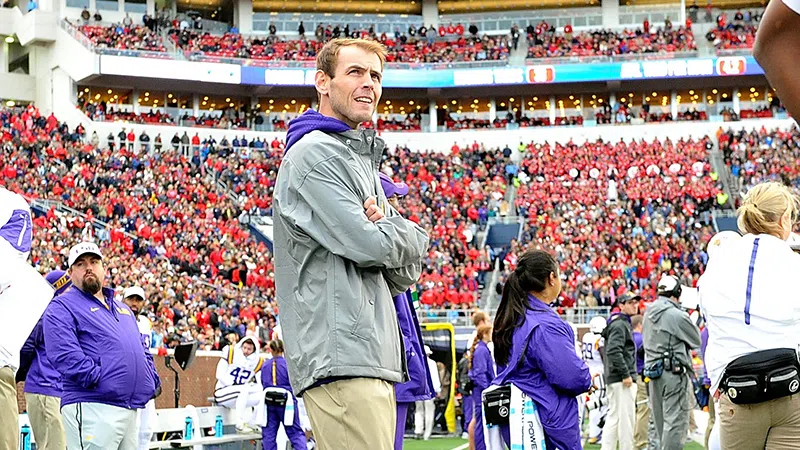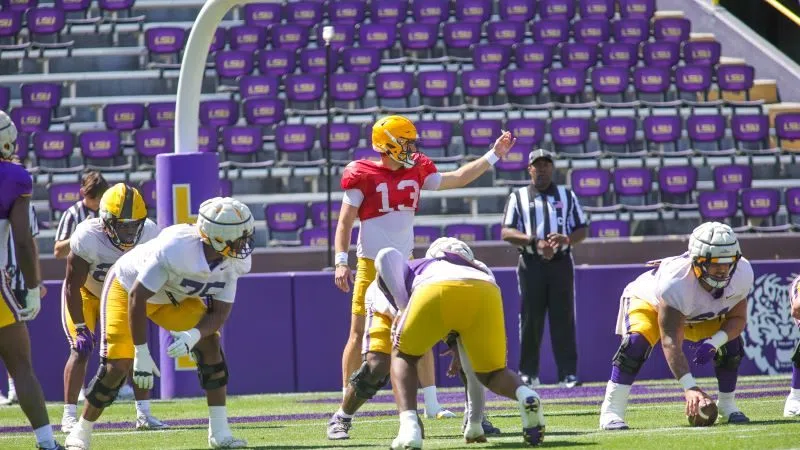
LSU Athletics
By Hunt Palmer
Investments of $18 million come with thoughtful consideration.
That’s what LSU has sunk into the 2025 football roster according to Brian Kelly. Arriving at that number took time, effort and a plan years in the making. Over the last five years, collegiate athletics has gone through a transformational time that has completely shifted the way rosters are built.
Between graduation, early NFL entries and transfers, 30, 40 or 50 players may walk out the door in January. Those numbers must be replaced annually. An incoming recruiting class from the high school ranks helps, but those players may not be ready to play, so transfers must be evaluated in a three-week period and added to the fold. In the NIL era, that costs significant money at a place like LSU.
As of June of 2025, that wasn’t LSU’s money. It had to come from the donors. In the spring of 2024, Kelly told WAFB’s Jacques Doucet, “we’re not the market of buying players.”
That tune changed within a matter of months when Kelly and LSU determined the only way to compete for championships was to fundraise and acquire talent with that cash.
LSU’s entire football operation was overhauled, led by General Manager Austin Thomas. During one of the open dates in 2024, Thomas and Athletic Director Scott Woodward flew to Seattle to meet with the Seahawks to better understand the financial aspect of building a roster. They studied how to best allocate funds position by position, year by year.
As they took notes and drew parallels, there was still and understanding that the landscape of college football differs greatly from the NFL’s structure.
“The NFL salary cap is about $280 million this year; ours is significantly less,” Thomas said. “For us, it is difficult because where at the next level there’s a lot of transparency, for us there’s none. Understanding that and being able to have a matrix you can launch from is very important. What they did is they really backed us and made us feel sound in our judgement and how we were building it and how we were allocating our funding across the positions and every spot within every position to maximize the compensation that we can pay our players as we moved into the revenue sharing era.”
On July 1, it became legal for athletic departments to share revenue with their student athletes. The 2025-26 maximum for each school was set at about $20.5 million. LSU has elected to allocate just north of $15 million, 75 percent, of that to football.
The rest of the money headed toward the 2025 football roster is from the donors. Thomas and Kelly had to make sure the deepest pockets in LSU’s base were on board.
“It took alignment,” Thomas said. “It took a vision from coaches. It took administration, TAF, a whole bunch of people involved to put us in a place where we could go out and educate our donor base and have them have and understanding of, and again speaking of the collective model that we were operating in, that education was critical to show people tangibly via PowerPoint presentation what we were doing, how we were building it and where their fundraising was going.”
With the plan in place, the donor-base was largely open to the message. Dollars started to pour into Bayou Traditions, the LSU collective created to collect money and distribute it to the student-athletes.
Prior to that July 1, 2025 date, that was the only place LSU could legally draw money from. When that changed and revenue sharing became a reality, LSU was prepared. In fact, LSU had been operating the budget as if the change had already been made.
“What we did was when we went out and presented to our donor base, we actually started operating like we were on the rev share in January,” Thomas said. “We allocated our funding that way so that we knew when this hit on July the first that it was going to be a very seamless transition. That was a very conscientious and intentional decision that we made this time last year to go out and say that. Starting January moving into July 1, our guys all just rolled over, and it was very seamless for us because we had already been operating out of that model. Was there some risk involved in that? Probably, but I felt like it was minimal in comparison to what it could have been doing it the other way.”
With that plan in action, LSU retained starting quarterback Garrett Nussmeier and key pieces like running back Caden Durham, tight end Trey’Dez Green, wide receivers Aaron Anderson and Chris Hilton, as well as young defensive linemen Dominick McKinley, Ahmad Breaux and Gabriel Reliford to set the foundation for the roster.
Then it was time to spend.
LSU added the top transfer portal class in the country which included 18 players, 17 from the power four conferences and a punter.
Thomas called the process “like speed dating” and suggested that LSU leaned on its roster matrix to determine what percentage of funds should go to each position to best attempt to curate a championship roster. Because they were planning in advance of the nearly $14 million influx of revenue sharing cash, they could be aggressive.
“From a rev share standpoint, it’s really, I don’t want to say predetermined, but I referenced this roster matrix that we worked with the NFL on that allowed us to at least have a launching point for every roster spot within every position,” Thomas said. “So, what that does is it becomes kind of our baseline, and then there’s other ways to work in the margins to enhance that compensation whether that’s in third party, whether that’s in some other creative things that we’re able to do to kind of maximize those areas. Again, just because that number is for that slot in the revenue share, that doesn’t mean that can’t move. There are a lot of metrics and a lot of data that drive that up and down based on where we are.”
Kelly’s job now becomes taking the 2025 Tigers to the next level, the College Football Playoff. Thomas shifts toward the future of the program with an understanding that an exodus is likely due to the age of this LSU roster. It’s a distinct possibility that upwards of 15 starters against Clemson will not be back for 2026.
The December 2025 transfer portal is still a mystery, but LSU continues to fill the pipeline with high school players that Thomas and the personnel department want to get to campus and keep on campus for the long haul.
That’s easier said than done, but LSU has a plan.
“A lot of it is really built, especially on the high school side, in relationships,” Thomas said. “We try to grow those roots so that you can withstand the test of time. Things come at you, recruiting conversations come at them. Again, if it’s driven by financials, in my opinion, that’s a house built on sand. So, a lot of times, those crumble.”
Thomas cut his teeth in college football as an elite relationship builder. He finds that trait essential in maintaining a stable program. Still, he understands the business side of the sport that wasn’t nearly as prevalent a decade ago.
Money matters.
“Financials are a part of the conversation, but what we try to do first is evaluate each other,” Thomas said. “We want them to get to know us, and we want to get to know them and who’s around them and who’s helping them in their decision-making process. From there, you can start having conversations about the fit and who they are and what they bring to our organization. At the end, this is about building a team, it’s not just collecting talent. It’s like a puzzle. You have corner pieces. You have edge pieces. You have center pieces. And they’re all different sizes. What you have to do, is you have to take those, and you have to take those and put them together to make them complete, make them whole.”

More LSU Sports












